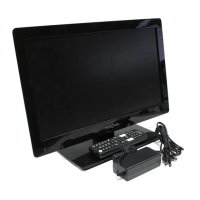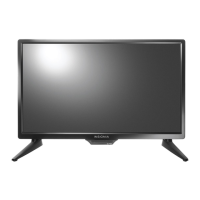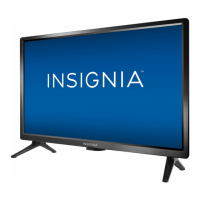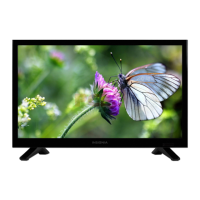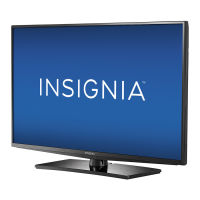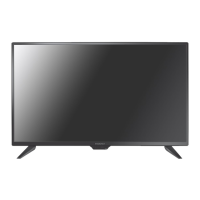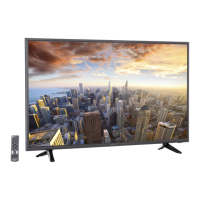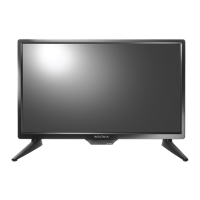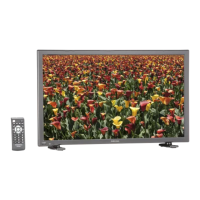Do you have a question about the Insignia NS-19E310NA15 and is the answer not in the manual?
General safety advice for children and TV placement.
Precautions and recommendations for safely mounting the TV on a wall.
Crucial warnings regarding electrical shock, liquids, ventilation, and heat.
Guidance on lightning, power lines, LCD panel handling, and replacement parts.
Instructions for service checks, antenna grounding, and CATV installer guidance.
Advice on condensation, mobile phone interference, and end-of-life disposal.
Welcome message and overview of the Insignia TV model.
Explanation of INlink CEC technology and Game Mode feature.
Step-by-step guide for attaching the TV stand to the display.
Instructions for removing the stand and attaching a wall mount bracket.
Final steps for securing the wall mount bracket using screws.
List of included items and description of front panel components.
Identification and function of buttons located on the top of the TV.
Description of ports and their functions on the side of the TV.
Description of ports and their functions on the back of the TV.
Detailed explanation of each button on the remote control.
Guidance on selecting optimal connection types for video quality.
Steps to connect a cable or satellite box using an HDMI cable.
Steps to connect a cable/satellite box using DVI with an audio connection.
Steps to connect a cable/satellite box using component video and audio cables.
Steps to connect a cable/satellite box using composite video and audio cables.
Steps to connect a cable/satellite box using a coaxial cable.
Instructions for connecting an antenna or cable TV without a set-top box.
Steps to connect a DVD or Blu-ray player using an HDMI cable.
Steps to connect a DVD/Blu-ray player using component video and audio cables.
Steps to connect a DVD/Blu-ray player using composite video and audio cables.
Steps to connect a game console using an HDMI cable.
Steps to connect a game console using component video and audio cables.
Steps to connect a game console using composite video and audio cables.
Steps to connect a computer to the TV using an HDMI cable.
Steps to connect a computer using DVI with an audio connection.
Steps to connect a computer to the TV using a VGA cable and audio.
Instructions for plugging a USB flash drive into the TV's USB port.
Steps for connecting headphones to the TV's audio out jack.
Steps to connect speakers or a sound bar using a digital coaxial audio cable.
Steps to connect speakers or a sound bar using an analog audio cable.
General diagram showing various device connections to the TV.
How to plug the AC power adapter into the TV and a power outlet.
Guide for inserting AAA batteries into the remote control.
Steps for the initial TV setup wizard, including language, time, and source selection.
Process for searching and storing available TV channels.
How to power the TV on, off, and into standby mode.
How to choose the active video input for connected devices.
Explanation of menu structure, screens, and navigation controls.
How to change channels, use number entry, and control volume.
Displaying details about the current program and channel.
Introduction to controlling HDMI CEC devices with the TV remote.
Setting connected devices to turn off automatically with the TV.
Setting the TV to turn on automatically when a connected device is powered on.
Using the TV remote to adjust volume for a connected audio receiver.
How to view a list of HDMI CEC devices connected to the TV.
Steps to select a device and access its root menu using the TV remote.
How to access the USB drive and browse photo files.
Accessing photos previously marked as favorites.
How to start and control a photo slideshow from the USB drive.
Adjusting slideshow options like repeat, shuffle, speed, and transition.
How to adjust picture mode, brightness, contrast, color, and sharpness.
Enabling or disabling the automatic adjustment of the picture's aspect ratio.
Configuring the TV's picture mode upon startup.
Fine-tuning image quality when connected via VGA.
Modifying sound mode, balance, bass, treble, and TV speakers.
Choosing how audio is outputted when headphones or speakers are connected.
Turning off the TV picture to listen to audio only.
How to scan for and store available channels.
Process to manually hide specific channels from the channel list.
Creating and accessing a list of preferred channels.
Assigning custom names to channels for easier identification.
Assessing the quality of the digital channel signal.
Overview of parental control features and password management.
Securing TV buttons and restricting unrated programs.
Configuring rating restrictions for US and Canadian TV and movie content.
Obtaining rating data to assist with parental control settings.
Turning the closed captioning feature on or off via the menu.
Choosing display modes for analog and digital closed captions.
Adjusting font, color, size, and effects for digital closed captions.
Configuring the TV's clock, date, and time zone.
Configuring the automatic TV turn-off timer.
Changing the language displayed in the TV's on-screen menus.
Customizing input names and managing automatic input detection.
Guidelines for cleaning the TV cabinet and screen.
Resetting TV to factory defaults and accessing system status.
Instructions for downloading and installing TV firmware updates via USB.
Solutions for issues like no picture, no sound, or picture filling the screen.
Solutions for problems like dark pictures, incorrect color, or dotted lines.
Solutions for audio noise, speaker output, and remote control malfunctions.
Troubleshooting universal remote controls, no power, and channel reception issues.
FCC, Industry Canada, Dolby, HDMI, and Energy Star compliance details.
Acknowledgement of trademarks like Dolby, HDMI, and Energy Star certification.
Details of the one-year limited warranty, coverage period, and what is covered.
How to obtain service and what situations are not covered by the warranty.
Detailed specifications for screen, tuner, inputs, outputs, and power.
Instructions and codes for programming universal remote controls to work with the TV.
| Screen Size | 19 inches |
|---|---|
| Display Type | LED |
| Resolution | 1366 x 768 |
| Refresh Rate | 60Hz |
| HDMI Ports | 1 |
| USB Ports | 1 |
| Inputs | Composite, RF |
| Sound Output | 10W (5W x 2) |
